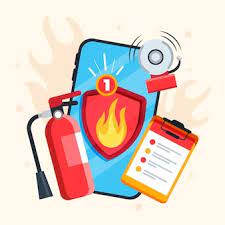
Fire safety is equally important in both log cabins and traditional homes, but there are specific factors that make fire safety considerations somewhat different for log cabins.
Building Material
Log cabins are typically constructed from wood, which is inherently more flammable than the materials used in traditional homes (e.g., brick, concrete, and drywall). This means that if a fire starts in a log cabin, it may spread more quickly.
Chimney and Wood-Burning Stoves
Many log cabins feature wood-burning stoves or fireplaces as a primary source of heating. These can pose additional fire risks if not properly maintained or used incorrectly.
Isolation and Location
Log cabins are often located in rural or wooded areas, which can be more prone to wildfires. They may also be far from fire departments, making rapid response more challenging.
Limited Fire Barriers
Log walls provide fewer natural fire barriers compared to traditional homes with gypsum board walls. This means that if a fire starts inside, it can spread more readily.
Due to these factors, log cabin owners should be especially diligent about fire safety measures, to protect both occupants and property. While the principles of fire safety remain the same, the context in which they are applied may differ, making awareness and proactive measures particularly important for log cabin owners. Here are some things to consider both for traditional and log cabin specific fire safety.
- Smoke Alarms and Carbon Monoxide Detectors: Install smoke alarms and carbon monoxide detectors in key areas of the cabin, including bedrooms, hallways, and near heating sources. Test them regularly and replace batteries as needed.
- Fire Extinguishers: Keep fire extinguishers in easily accessible locations throughout the cabin. Ensure that everyone knows how to use them effectively.
- Clear Escape Routes: Maintain clear and unobstructed exit paths from all rooms. Establish and practice a fire escape plan with your family or guests.
- Heating Safety: If you have a wood-burning stove or fireplace, have them inspected and cleaned regularly. Use a spark screen to prevent embers from escaping. Keep flammable items away from heating sources.
- Safe Fireplace Practices: Burn only seasoned firewood, and never leave a fire unattended. Use a sturdy screen or glass door to contain sparks and embers.
- Proper Electrical Wiring: Ensure that all electrical wiring is up to code and not damaged. Avoid overloading outlets and replace frayed or damaged cords.
- Cooking Safety: Exercise caution when cooking, especially with open flames. Keep flammable materials away from the stove, and never leave cooking unattended.
- Candle Safety: If using candles for ambiance, place them in stable holders and never leave them burning in unoccupied rooms.
- Chimney Maintenance: Have your chimney cleaned and inspected regularly to prevent the buildup of creosote, which can cause chimney fires.
- Firebreaks and Defensible Space: Maintain a cleared area around your cabin to create a defensible space that reduces the risk of wildfires. Remove dead vegetation and create firebreaks if necessary.
- Emergency Contacts: Keep a list of emergency contacts, including local fire and rescue services, near your phone.
- Firewood Storage: Store firewood away from the cabin to prevent pests and reduce the risk of accidental ignition.
- Fire Safety Education: Educate all cabin occupants, including guests, about fire safety practices and procedures.
It is important to be diligent with regular maintenance, awareness, and preparedness to ensure fire safety in your log cabin. As well as taking preventive measures to reduce the risk of fires and respond effectively in case of an emergency.








